A 2-hole button is considered the most common type of hardware, as opposed to flat 4-hole fasteners. They are attached to coats, dresses, pants, skirts, and shirts. It is easy to sew on such fittings, but the design must be strong enough. Below you can find step-by-step instructions on working with different fasteners.
Rules for sewing on buttons with two and four holes
If a button has come off and is lost, it can be replaced with a spare one, which is often included with many buttoned items. If it is missing, you can find a similar one or completely replace all the fittings.
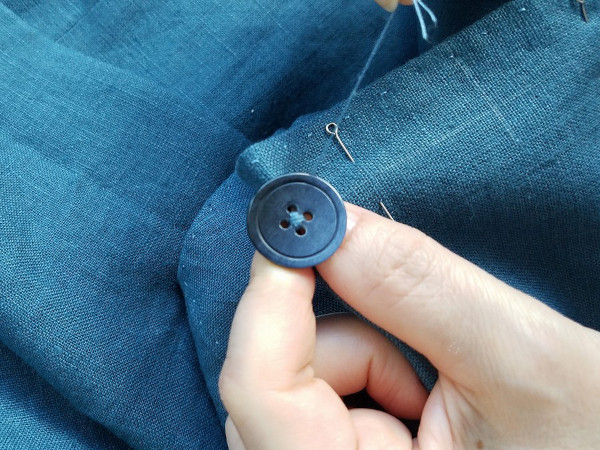
You can sew on a button with 4 holes or 2 holes by following these rules:
| Terms and Conditions | Peculiarities |
| A piece of dry soap or sewing chalk | To fasten the clasp properly, you must first decide on the place where the button will be located. The place must be marked. Soap or sewing chalk are great because all traces will disappear after washing. |
| Ruler | It is necessary to place the edges of the item on top of each other, measuring and marking the points where the hardware fasteners will be located. |
| Hammer | Required if a special metal fastener needs to be installed on jeans. |
| Thimble | It is necessary to use it when interacting with dense materials, so as not to injure your fingers with the needle. |
| Scissors | The scissors must be sharp so that the ends of the threads do not fray. |
| Sub-button | It is necessary if a fur coat, raincoat or coat is deformed. It is a small button that is sewn on the inside of the product. It allows you to reduce the load on the fastener without damaging the material. It must be fixed to the clothes together with the main fittings. |
| Match | Can be replaced with a toothpick or a comb with rare teeth. The match is needed to create a leg that will not allow the material to tear, wrinkle or tighten at the fastening point. At the same time, the fittings will easily pass through the loop. |
Preparation of fabric material:
- on a fur coat, sheepskin coat or overcoat, the tear should be sewn up with a furrier's stitch, and a patch should be made or reinforced as needed;
- when interacting with thin material, it is recommended to glue the area from the back side using a special adhesive-based material;
- If the denim material is deformed, a piece of suitable denim material should be placed between the layers of the belt, stitching the gap with threads in the same shade.
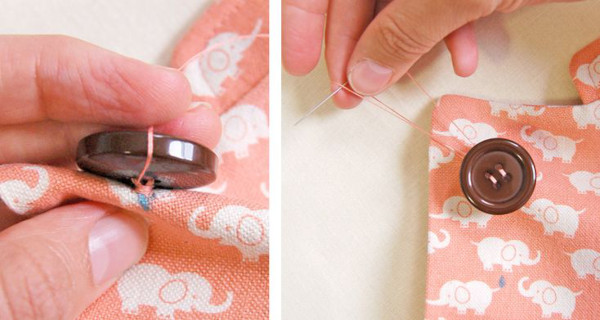
If a modern sewing machine has a button sewing function, you can use it. The kit includes a foot and a plate that adjusts the formation of loops.
When selecting the optimal width of the zigzag stitch, sew at a low speed. Often, you can use a standard needle and thread if the fabric does not require special handling.
Useful tips for fixing decorative elements:
- To speed up the process, it is permissible to use a double thread.
- There is no need to wait until the fittings are lost, otherwise you will have to replace the entire set. After washing and ironing, it is necessary to inspect the threads.
- An extra set of buttons and fittings should be kept from the moment of purchasing outerwear. Often the set is attached to items in a bag in the amount of 4 pieces. If the set is missing, then the product is from a low-quality manufacturer.
- When wearing one type of clothing constantly, it is advisable to rewind the thread leg several times after sewing on the fittings, then thread the needle through the bundle and fix it with a stitch on the back. As a result, there will be additional protection that will protect the threads from abrasion.
- From the back side, the button should be fixed carefully, just like from the front side.
- You don't have to make a knot to secure it. You can make a few stitches on the material before and after sewing. The end of the thread should be tied in a knot.
- Fittings with multiple holes should be sewn on in the same way as those that were originally fixed with diagonal or parallel stitches.
What threads are best to use?
Threads of any thickness can be used to sew on fittings. However, excessively thick threads can worsen the condition of the stock and the item as a whole. It must be selected so that it harmonizes with the holes in the fittings and is practical to work with.
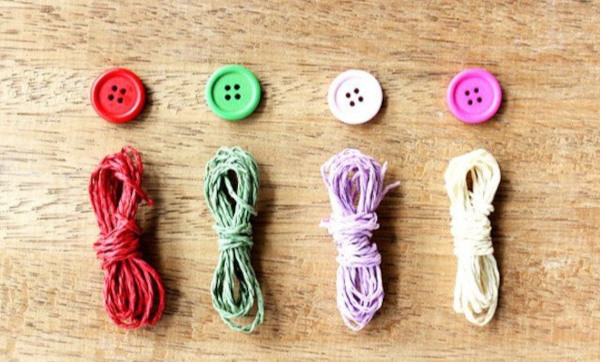
The thread should match the item in shade. The task is much easier if the item and fittings match in color and shade.
If they are different, you need to consider what type of button it is:
- if the butt is on a leg, when selecting threads it is necessary to take into account the shade of the material, since it will not be visible from the outside;
- clasps made on the outside can slightly hide the shade;
- The shade of the flat fittings should match the shade of the thread.
The thread for sewing on accessories should have an optimal length, which varies within 30 cm, no more. If it is too long, the thread will get tangled, creating small noticeable knots and discomfort during work. If it is too short, it will not be possible to complete the entire volume of sewing.

The shade of the fittings plays a significant role:
- white fittings symbolize success in business;
- choosing a red button means that a person is in love;
- yellow or green fittings mean financial success;
- The lilac shade indicates hidden talents.
Selecting a needle and initial thread fixation
Before sewing on the fittings, you need to decide on the working tool in the form of a needle. Often, a medium-sized needle is considered optimal. However, when interacting with a fairly dense fabric material, a needle with an average length and diameter will not work.
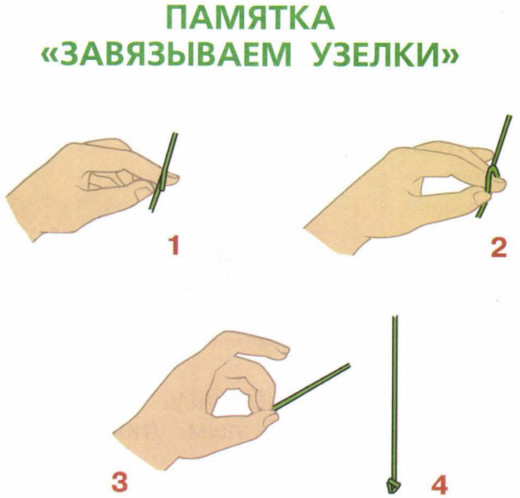
The end of the thread should be tied into a knot during sewing. The process can be carried out with 1 or 2 threads. Everything will depend on the size of the fittings. For small buttons, you can use one thread, for larger ones, it is recommended to use two threads so that the fastening is more reliable.
When choosing the needle size, you should rely on a few simple rules:
- a thick needle with a large eye is suitable for thick winter clothing such as a sheepskin coat, fur coat or leather items;
- A sharp and thin needle is perfect for thin and light fabrics such as viscose, silk, satin, to pierce the material evenly and without snagging.
During work, it is recommended to use a thimble, which will protect your fingers from punctures when fixing the fittings to thick and dense material.
A 4-hole button can be sewn on using a medium-sized needle, which is ideal for any type of fabric. At the same time, there should be a knot at the end of a small piece of thread to initially fix the thread.
Final fixation of the thread
A secure fastening and final fixation of the thread will be achieved by threading the needle through the fabric fibers from the back side. This can also be achieved by fixing the knot with a formed loop.
How to sew a button on a shank
It is permissible to make a leg for a button with 2 or 4 holes if the fittings are flat. This element will easily pass through the loop and will not come off. Despite the fact that the button has its own leg, it is permissible to make an additional one to expand the clothing and increase the durability of attributes and fabric material. Legs are missing only for those items that are sewn on with a sewing machine.
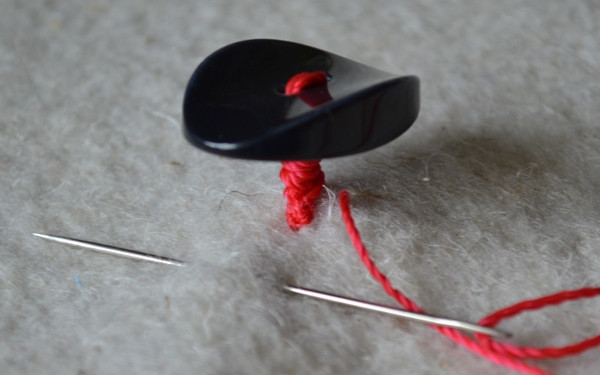
To create a leg between the fabric and the element, it is necessary to put a rod from a pen or a match to create a small gap between them. This is required in order to easily wrap the thread around the leg and freely put the loop on the fittings. The lining based on a rod or a match can be installed both under and above the product.
If the fabric is delicate and thin, it is recommended to use thin needles or pins as a lining. For strong and thick fabric, it is better to use a match intended for lighting an oven.
Instructions for fixing the decor on the leg:
- Find the area where the old fittings were located. Get rid of the old threads.
- Carefully pierce the material from the back where the old threads were previously located.
- Pull the thread to the end, bending it past the match.
- Pass the thread through the eye, pulling it tight.
- Thread the needle through the other end of the pin or match.
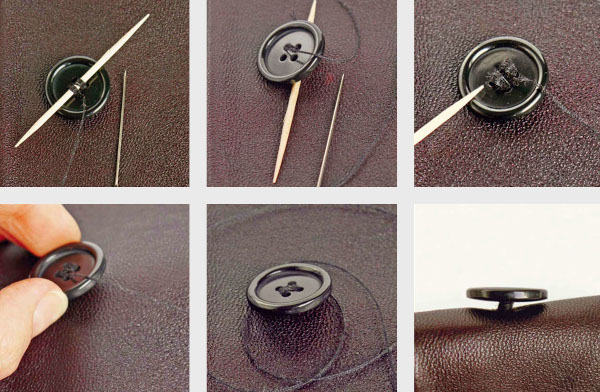
If the fittings have four holes, the stitches can be made in parallel lines or crosswise. 10 times is enough for this. However, each new stitch must be made from a different part of the lining.
How to sew on a flat button
There are different ways to sew on a 4-hole button.
The following are considered simple and in demand:
- square stitches;
- parallel lines;
- arrow stitches;
- cross stitches.

There are several other options for attaching decoration to clothing if the button consists of 4 holes:
- in the form of the letter "I" from the Cyrillic alphabet;
- in the form of a square with a cross;
- in the shape of the letter "Z" from the Latin alphabet.
Any fixation option looks beautiful and neat, but this requires choosing the right needle and thread.
With two holes
To achieve the same height of the foot-pad when creating a new stitch, it is recommended to use auxiliary tools that act as a pad between the clothing and the fabric. In this case, you can use pen rods, matches, hairpins or pins. After finishing the work, such pads are easy to remove.

Medium-thickness thread is suitable for sewing on fittings with two holes, since too thin threads look untidy on the sewn-on element. When the thread is threaded through the needle, one end of it should be tied into a small knot. After fixing it on the clothes, use a piece of soap to mark the placement of the decor on the item. To do this, it is enough to apply a small cross on the outside.
Instructions for sewing flat decoration with two holes:
- After making the marks, make a puncture from the inside, bringing the needle out. The thread should be placed above the middle of the mark.
- Thread a thread through one hole onto a needle and pass it through the other hole.
- The fittings will look neater if they fit into the same hole that was previously marked.
- When you repeat the above action several times, the thread should look like one piece.
- Upon completion, secure the sewn-on element.
It is not advisable to tighten the thread while sewing, since an excessively tight thread will create a tight joint between the fittings and the product. As a result, the latter will be difficult to fasten. The thread must be tightened with a loop that was created by wrapping the thread around the element and threading the free edge through the loop.
This manipulation must be performed several times, shortening the remaining thread. As a result, the fixed butt will be securely sewn, fulfilling its purpose.
Replacing the fittings on jeans is very difficult, so it is recommended to use a flat button with two holes instead of a metal element on the leg. This work will not differ from fastening other fasteners. However, if you want to keep the original fittings, you need to use a hammer and select an appropriate replacement.
Jeans fittings can come in different formats:
- on a strong leg with or without a hole in it;
- on a broken leg;
- with double fastening.
Each format has its own installation nuances, so it is often better to take the clothes to a workshop that repairs items.
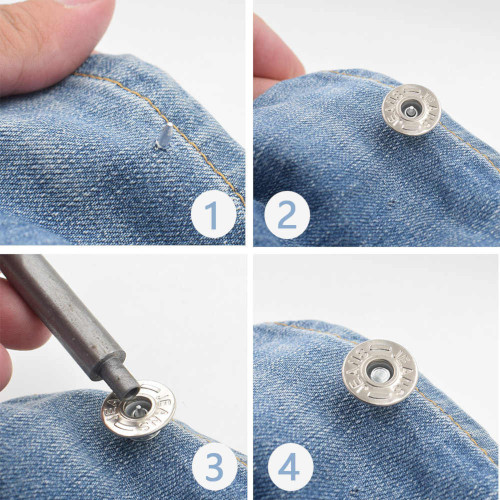
To independently return metal fittings to a stable leg, you must:
- Use a hand punch or an awl to make a hole for fastening.
- Insert the bottom part of the fitting into the hole.
- Attach the cap to the leg of the element.
- Turn the jeans inside out and place them on a hard, flat surface.
- Hit the rivet with a hammer using a light motion so as not to damage the button.
With four holes
Sewing on a 4-hole button is a little more difficult than a 2-hole button.
Step by step instructions:
- Thread the needle. To speed up the work, use a double thread. In this case, place the thread in the eye of the needle so that there is an identical number of threads on each side.
- Tie the end of the thread into a knot. If you choose the double option, tie the ends so that there is enough material left for sewing.
- Place the fittings in the desired location. Using a needle, pass the thread through the material and one of the holes on the element. With each stitch, pull the thread completely so that nothing remains.
- Place a pin between the new and existing stitches under the hardware to leave a small amount of space.
- Pass the needle and thread diagonally through the opposite hole. Pass the thread through 2 holes again, repeating the same process with the remaining two holes.
- Remove the pin and wrap the excess thread around the threads located between the fabric and the fittings. Pass the needle through the fabric.
- Make two stitches under the element. Tie the thread into a knot, cutting off the remaining part.
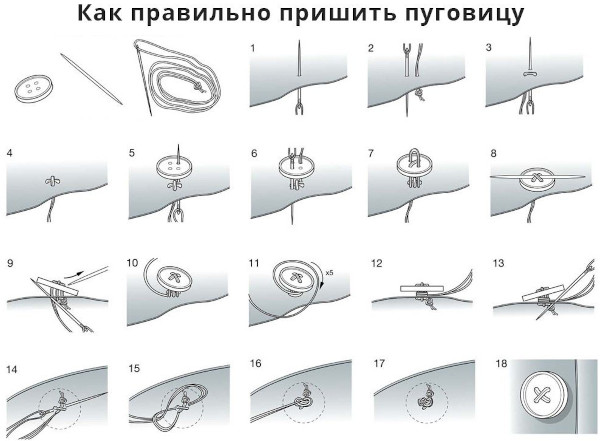
Sewing a four-hole button on a coat will be a more difficult process, since the material and lining are quite dense. In this case, it is necessary to prepare a buttonhole for sewing.
Step by step instructions:
- Mark the areas on the product where the fasteners will be fixed.
- Pierce the fabric from the front side, pulling the threads to the knot stop relative to the back side.
- Thread the buttonhole and pull the thread back.
- Thread the thread through the hole in the large fitting.
- Make a tie-in with the buttonhole using a few light stitches.
- Fix two fittings in the same way as the others.

Four-hole fittings can be sewn on in a square shape.
To do this, you need to follow these steps:
- From the front side, pierce the fabric so that the knot remains under the decor.
- Thread the fittings onto the needle and into the next hole to form a stitch.
- Repeat the stitch several times. Do the same with the remaining holes so that the stitches create a square.
- Bring the needle out between the fabric and the decoration, securing it with a few stitches.
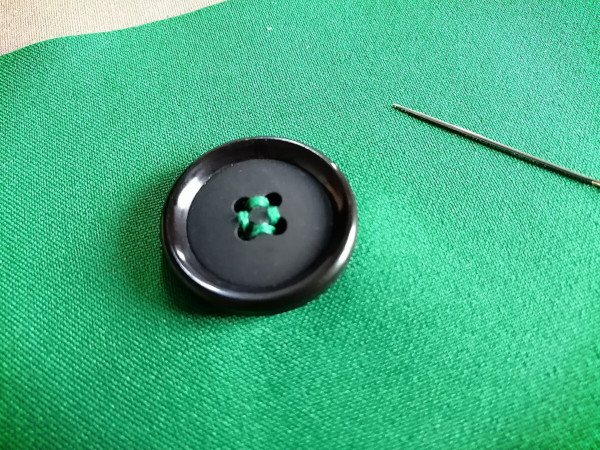
Sewing on buttons is considered a tedious process, especially if the fittings consist of 2 or 4 holes. However, such work can be optimized if the fasteners are sewn on the fold of the fabric on lightweight items. For a more accurate job, it is recommended to fix the fittings on the fabric in one puncture.
Video about sewing on buttons
How to sew on different types of buttons:
